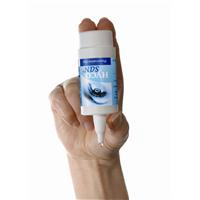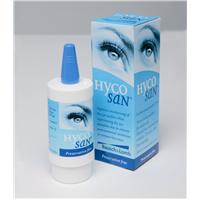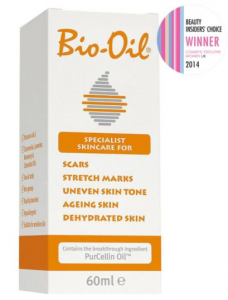

Theres no disputing the fact that modern lifestyles are wreaking havoc on our eyes with eight-hour days spent staring at a computer screen, and intense air-conditioning, cigarette smoke and pollution adding to the issue, associated health problems such as Dry Eye syndrome are becoming increasingly prevalent.
In fact, Dry Eye syndrome (also referred to as keratonconjunctivitis sicca) has now become one of the most common problems treated by eye specialists in the UK1. Characterised by a feeling of grittiness or soreness (but not necessarily a feeling of dryness), the condition is often accompanied by a reddening of the eye area and watery eyes, particularly when exposed to the wind.
But now help is at hand in the form of Bausch & Lombs Hycosan – a preservative-free formula designed to soothe and moisturise dry eyes. Hycosan incorporates the active ingredient sodium hyaluronate, a naturally occurring polysaccharide found to relieve symptoms of ocular discomfort through water binding properties that reduce evaporation, mimicking the natural tear film and increasing tear break-up time.
Each one-click, one-drop bottle contains 300 doses in a patented one-way delivery system which allows for safe and effective multiple use, and ensures that the product remains contamination-free for up to 12 weeks after first opening. The soothing formulation is ideal for those with sensitive eyes and for use with both soft and hard contact lenses.
Consultant Ophthalmologist at the Hillingdon Hospital, Mr Nick Lee said: A combination of environmental factors and medical conditions make dry eyes increasingly common for people in the UK. Keeping the eyes well lubricated is essential not only for comfort but also to protect the eyes from developing other complaints which can be far more serious.
Hycosan is available from Dollond and Aitchison, plus independent pharmacies and opticians, priced £12.99 (RRP) for three months supply.
We have 20 of these to give away. Please email us at readeroffer@elixirnews.com with your name and address and Eye in the email header by July 30. Please note that no cash equivalent is being offered and the Editor’s decision is final.
1 International Glaucoma Association
Dry Eye Syndrome
In addition to our lifestyles, factors such as hot, dry or windy climates, high altitudes, common medication and allergies such as hay fever can trigger symptoms. Thyroid disorders, vitamin A deficiency, Parkinsons disease and hormonal changes as women enter the menopause may also cause dryness.
While an irritating and uncomfortable condition in its own right, particularly dry eyes can cause complications, damage eye tissue, scar the cornea (the front covering of the eyes) and causing infections such as conjunctivitis and even impair vision.
Bausch & Lombs Hycosan
Bausch & Lombs Hycosan is a preservative-free formula designed to soothe and moisturise tired, dry-feeling eyes.
Hycosan incorporates the active ingredient sodium hyaluronate, a naturally occurring polysaccharide found to relieve symptoms of ocular discomfort through water binding properties that reduce evaporation, mimicking the natural tear film and increasing tear break-up time.
Each one-click, one-drop bottle contains 300 doses in a patented one-way delivery system which allows for safe and effective multiple use, and ensures that the product remains contamination-free for up to 12 weeks after first opening.
The soothing formulation is ideal for those with sensitive eyes and for use with both soft and hard contact lenses.
Hycosan is available from independent pharmacies and opticians, priced £12.99 (RRP) for three months supply. For further information, please visit www.bausch.com
Bausch & Lomb
Bausch & Lomb is the eye health company, dedicated to perfecting vision and enhancing life for consumers worldwide. Its core businesses include soft and rigid gas permeable contact lenses and lens care products, and ophthalmic surgical and pharmaceutical products.
The Bausch & Lomb name is one of the best known and most respected healthcare brands in the world. Founded in 1853, the company is headquartered in Rochester, New York, and employs approximately 13,000 people throughout its international office network. Its products are available in more than 100 countries.
DRY EYE SYNDROME
Frequently Asked Questions
What is dry eye syndrome?
Our eyes are always covered by a thin layer of liquid, most commonly known as a tear film, which is made from of a mixture of water, proteins, fats, mucus, and infection-fighting cells. As well as lubricating the eye, the tear film also keeps the area clean, stabilises vision and protects the eye against infection.
Dry eye syndrome (also known as keratoconjunctivitis sicca) refers to a spectrum of ocular surface diseases which are caused when the eyes do not make enough tears, or those tears evaporate too quickly.
What are the symptoms?
Symptoms of dry eye syndrome include:
Feelings of dryness, grittiness, or soreness, in one or both eyes which get worse throughout the day
Redness
Watery eyes, particularly when exposed to wind
Eyelids stuck together on waking
What causes dry eye syndrome?
Many factors, such as hot, dry or windy climates, high altitudes, air-conditioning, prolonged use of contact lenses and cigarette smoke can contribute to dry eye syndrome. Some people also find their eyes become irritated when reading or working at a computer.
Dryness can also be caused by medication such as antihistamines, nasal decongestants, birth control pills, some treatments for high blood pressure, antidepressants and isotretinoin tablets for acne.
Thyroid disorders, vitamin A deficiency and Parkinsons disease may cause further dryness. Women also frequently experience problems with dry eyes due to hormonal changes as they enter the menopause.
How common is it?
According to the International Glaucoma Association, dry eye syndrome is one of the most common problems treated by eye specialists in the UK. Studies have suggested that between 17% and 30% of people experience dry eye syndrome at some point during their life.
Who is affected by dry eye syndrome?
Dry eye syndrome is more likely to affect people who are over the age of 50, and the condition is more common among women than men.
Complications of dry eye syndrome
If left untreated, dry eye syndrome can cause complications, such as scarring of the cornea (the transparent layer at the front of the eye) and conjunctivitis (inflammation or infection of the eye), making it important to consult a GP or eye health specialist as soon as possible.
Such complications produce symptoms such as:
Sensitivity to light
Redness
Pain in the eyes
Deterioration in vision
Diagnosis
A GP should be able to diagnose dry eye syndrome after discussing the symptoms and your medical history. An examination may be carried out to check for other conditions and complications.
The GP will also want to know about any medicines that you are taking, as well as your personal circumstances, in case a possible cause of dry eye syndrome can be identified.
Ø Referral to an optometrist
Your GP may refer you to an optometrist for a check up, who will use specialist equipment to examine your eye. The optometrist will also be able to give you advice about treatment. Optometrists are private practitioners and charge for their services.
Ø Referral to an ophthalmologist
If the diagnosis is uncertain, or specialist tests and treatment are required, your GP may refer you to an ophthalmologist – a surgeon who specialises in eye diseases.
If you have an underlying medical condition which is causing dry eye syndrome, your GP will prescribe treatment for it.
Most people with dry eye syndrome also have blepharitis, which is a common (and usually mild) chronic inflammation of the rims of the eyelids. The basis of treatment of blepharitis is eyelid hygiene. In other words, keeping the eyelids clean, and massaging any trapped material out of the glands in the rim of the eyelid.
If your underlying condition is a complex one, such as HIV, or lupus, you will need to be referred to a specialist for treatment, if you are not already receiving treatment for the condition.
Treatment
Although no cure exists for dry eye syndrome, there are a range of treatments which can control your symptoms.
Ø Artificial tears
Mild to moderate cases of dry eye syndrome can often be treated with eye drops that contain ‘artificial tears’ – a liquid that is designed to mimic the properties of the tear film. These eye drops are available from a pharmacy over-the-counter (OTC) without prescription.
Bausch & Lombs Hycosan is a preservative-free formula designed to soothe and moisturise dry, tired-feeling eyes. Hycosan incorporates the active ingredient sodium hyaluronate, a naturally occurring polysaccharide found to relieve symptoms of ocular discomfort by reducing evaporation, mimicking the natural tear film and increasing tear break-up time.
Hycosan is available from Dollond & Aitchison, plus independent pharmacies and opticians, priced £12.99 (RRP) for three months supply.
Ø Anti-inflammatory medicine
Anti-inflammatory medicines work by blocking the functions of your immune system that are involved in triggering inflammation, and are usually prescribed by a GP in the form of a cream, or ointment.
Ø Specialised eyewear
Some cases of dry eye syndrome can be treated using specialist eyewear. These include specially made glasses, known as moisture chamber spectacles, which wrap around your eyes like goggles, helping to retain moisture, and protecting eyes from irritants.
Progress in contact lens manufacture has meant that many are designed specifically for people with dry eyes and lock in moisture. Talk to your optometrist for details.
Ø Surgery
If dry eyes fail to respond to other forms of treatment, surgery may be an option.
Punctual occlusion, involves using small ‘plugs’ to seal the tear ducts, which help keep the eye protected by tears. Temporary plugs made of silicone are usually used in the first instance to see if the operation has a positive effect. If it has, more permanent plugs can be used to replace the silicone ones.
Self-care
There are several self-care techniques that can help prevent, or reduce, the symptoms, of dry eye syndrome:
Ø Keeping your eyes clean will help prevent dry eye syndrome
Ø Massaging the eyes by gently rolling your first finger over the upper lid in a circular motion will help to push out any of the mucus-like fluid from the tiny eyelid glands.
Ø Protecting your eyes from wind and hot air by wearing a pair of wraparound glasses will help prevent them drying out
Ø Positioning your computer workstation correctly will minimise eye strain. Your monitor should be at, or just below eye level and you should ensure you take regular breaks away from it during the day
Ø Stopping or avoiding smoking can help to reduce irritation to your eyes
Ø Using a humidifier at work and at home will help moisten the surrounding air. Opening windows for a few minutes on cold days, and longer in the spring, and summer will also help to keep the air moist
Ø Eating a diet that is high in omega-3 fats, can help prevent dry eye syndrome because the fats are used in the production of tears. The best source of omega-3 fats are oily fish, such as mackerel, salmon, sardines, tuna, and herring
Bausch & Lomb
Bausch & Lomb is the eye health company, dedicated to perfecting vision and enhancing life for consumers worldwide. Its core businesses include soft and rigid gas permeable contact lenses and lens care products, and ophthalmic surgical and pharmaceutical products.
The Bausch & Lomb name is one of the best known and most respected healthcare brands in the world. Founded in 1853, the company is headquartered in Rochester, New York, and employs approximately 13,000 people throughout its international office network. Its products are available in more than 100 countries.
More information about the Company can be found on the Bausch & Lomb Web site at www.bausch.com



